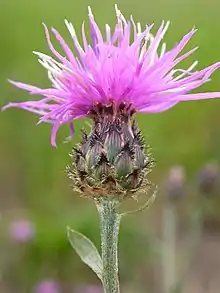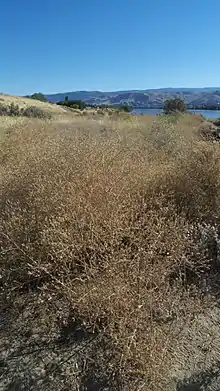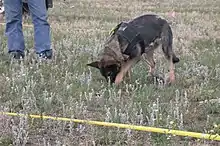Centaurea stoebe
Centaurea stoebe, the spotted knapweed or panicled knapweed,[1] is a species of Centaurea native to eastern Europe, although it has spread to North America, where it is considered an invasive species. It forms a tumbleweed, helping to increase the species' reach, and the seeds are also enabled by a feathery pappus.
| Spotted knapweed | |
|---|---|
 | |
| Scientific classification | |
| Kingdom: | Plantae |
| Clade: | Tracheophytes |
| Clade: | Angiosperms |
| Clade: | Eudicots |
| Clade: | Asterids |
| Order: | Asterales |
| Family: | Asteraceae |
| Genus: | Centaurea |
| Species: | C. stoebe |
| Binomial name | |
| Centaurea stoebe | |
Description
Centaurea stoebe is a biennial or short-lived perennial plant, and it usually has a stout taproot and pubescent stems when young. It has pale and deeply-lobed leaves covered in fine short hairs. First-year plants produce a basal rosette, alternate, up to 15 centimetres (6 inches) long, deeply divided into lobes.[2] It produces a stem in its second year of growth. Stem leaves are progressively less lobed, getting smaller toward the top. The stem is erect or ascending, slender, hairy and branching, and can grow up to 0.91 metres (3 feet) tall. Protruding from black-tipped sepals, the flower blooms from July to September.[3] The flower head is 10 millimetres (3⁄8 in) wide, with vibrant pink to lavender (or more rarely white) disc flowers around 2 cm (3⁄4 in) long; the corolla of each has five narrow lobes.[3] The fruit is an achene about 6.4 mm (1⁄4 in) long with a short, bristly pappus. These are primarily dispersed by wind, sometimes assisted by the plant's tumbleweed mode.[4]
Taxonomy
C. stoebe was formerly known as C. maculosa. Two cytotypes of C. stoebe exist which have been considered as different species by some taxonomists. The diploid form of the plant is now called C. stoebe L. spp. stoebe, while the tetraploid is known as C. stoebe L. spp. micranthos or by some taxonomists as C. biebersteinii DC.[5] The names of C. stoebe and C. biebersteinii may have been accidentally switched early in the plant's taxonomic history.[3]
The common name spotted knapweed refers to the black-tipped sepals that look like spots.
Distribution and habitat
The species is native to eastern Europe.[6][7] It is also an invasive species in southern Canada, and northwestern Mexico, and nearly every state in the United States; it has thrived in the western US in particular, much of which has a dry climate similar to the Mediterranean.
The plant grows on stream banks, pond shorelines, sand prairies, old fields and pastures, roadsides, along railroads, and in many open and disturbed areas.[3] It is relatively tolerant of cold and reaches into alpine environments.[8]
Ecology
Centaurea stoebe has been introduced to North America,[9] where it is considered an invasive species in much of the western US and Canada. In 2000, C. stoebe occupied more than 7 million acres (28,000 square kilometres) in the US.[10]
Spotted knapweed is a pioneer species found in recently disturbed sites or openings, growing in dense stands.[3] As such, human disturbance is a major cause of infestations. It readily establishes itself and quickly expands in places of human disturbance such as industrial sites,[11] along roadsides, and along sandy riverbanks. Once established, it also has the potential to spread into undisturbed natural areas.[2] Because cattle prefer the native bunchgrass over knapweed, overgrazing can often increase the density and range of knapweed infestations.[12] This species is believed to have several traits that contribute to its extreme competitive ability:
- A tap root that sucks up water faster than the root systems of its neighbors.
- Rapid dispersal through high seed production.
- Low palatability, making it less likely to be eaten.
- Its purported allelopathy allows it to thrive by stunting the growth of neighboring plants.
History in North America

Spotted knapweed likely spread to North America in an alfalfa shipment. It was first recorded in Bingen, Klickitat County, Washington, in the late 1800s. By 1980, it had spread to 26 counties in the Pacific Northwest.[13] In the year 2000, it was reported in 45 of the 50 states of the US. Spotted knapweed primarily affects rangelands of the northwest US and Canada.[14] A 1996 study estimated the direct plus secondary economic impact of spotted knapweed in Montana to be approximately $42 million annually.[15] When spotted knapweed replaces native grasses, soil erosion and surface runoff are increased,[16] depleting precious soil resources.
In 2015, a Missoula, Montana, beekeeper whose bees rely on local knapweed stated that "knapweed produces great honey ... people should consider planting native wildflowers instead of just taking out weeds."[17]
Catechin controversy
The roots of Centaurea stoebe exude (-)-catechin, which has been proposed to function as a natural herbicide that may inhibit competition by a wide range of other plant species.[18] While this phytotoxic compound can inhibit seed germination and growth at high concentrations, it is debated whether concentrations in field soils are high enough to affect competition with neighboring plants. Several high-profile papers arguing for the importance of catechin as an allelochemical were retracted after it was found that they contained fabricated data showing unnaturally high levels of catechin in soils surrounding C. stoebe.[19][20] Subsequent studies from the original lab have not been able to replicate the results from these retracted studies, nor have most independent studies conducted in other laboratories.[21][22] Thus, it is doubtful whether the levels of (-)-catechin found in soils are high enough to affect competition with neighboring plants. The proposed mechanism of action (acidification of the cytoplasm through oxidative damage) has also been criticized, on the basis that (-)-catechin is actually an antioxidant.[22]
Control

An 8-year study in Michigan found that restoring native plant communities in knapweed-infested sites requires multi-faceted and multi-year approaches. This includes an initial site preparation by mowing and an optional application of a clopyralid or glyphosate herbicide followed by reseeding with the desired plant communities. Yearly hand pulling of C. stoebe over the course of the study virtually eradicated the infestation. Burning treatments of infested sites reduced the labour needs for pulling and encouraged native plant community establishment.[23]
Another study over 3 years comparing the effectiveness of different combinations of annual spring, summer, and fall mowing treatments recommends an annual fall mowing during the flowering or seed-production stage in controlling C. stoebe infestations.[24]
Biocontrol
Thirteen biological pest control agents have been used against this plant and its congener, diffuse knapweed (C. diffusa), including the moths, Agapeta zoegana and Metzneria paucipunctella; the weevils, Bangasternus fausti, Larinus obtusus, Larinus minutus and Cyphocleonus achates; and the fruit flies, Chaetorellia acrolophi, Urophora affinis and Urophora quadrifasciata.[25] Although the number of seeds is significantly reduced, this is not enough to make biocontrol truly effective against C. stoebe.[3][26] In some instances, root-herbivory on C. stoebe stimulates additional release of catechin, which may function as an allelopathic toxin.[27] In addition, moderate levels of herbivory by biocontrol agents can cause compensatory growth.[28]
Prescribed grazing
Prescribed grazing may be an effective means of controlling infestations, as all growth forms of C. stoebe are nutritious to sheep. High-density infestations can be controlled by fencing in the affected area with sheep until the desired level of removal is achieved.[29]
Detection

Detection dogs can be trained to locate small infestations of invasive, non-native weeds. Previous methods of detection involved lining up dozens of volunteers to locate the small rosettes buried somewhere on a large parcel of land covered with other vegetation.
Montana State University successfully completed field testing in 2004. The dog, Knapweed Nightmare was finding low densities of the non-native invasive knapweed plant in the field with an overall success rate of 93%.[30] She followed it up with 98% in the final trials in open fields, demonstrating that dogs can effectively detect low densities of invasive plants.[31]
Toxicity
Handling the plant barehanded is rumored to possibly cause tumors, particularly if one has an open wound, but there is little evidence to support this theory.[3][4]
References
- "Taxon profile: Spotted Knapweed - Centaurea stoebe L." BioLib: Biological library.
- Somers, Paul (2008). A guide to invasive plants in Massachusetts. Massachusetts Division of Fisheries and Wildlife. p. 39.
- Spellenberg, Richard (2001) [1979]. National Audubon Society Field Guide to North American Wildflowers: Western Region (rev ed.). Knopf. p. 363. ISBN 978-0-375-40233-3.
- Elpel, Thomas J.; Sherman, Pamela G. "Centaurea maculosa, C. Diffusa: Spotted and Diffuse Knapweed. Weed control". Wildflowers-and-Weeds.com. Retrieved 2022-07-04.
- Blair, Amy; Nissen, Scott J.; Hufbauer, Ruth A.; Brunk, Galen R. (September 2006). "A lack of evidence for an ecological role of the putative allelochemical (±)-Catechin in Spotted Knapweed". Journal of Chemical Ecology. 32 (10): 2327–2331. doi:10.1007/s10886-006-9168-y. PMID 16955253. S2CID 2450684.
- itis.gov
- "Centaurea stoebe in Tropicos".
- Taylor, Ronald J. (1994) [1992]. Sagebrush Country: A Wildflower Sanctuary (rev. ed.). Missoula, MT: Mountain Press Pub. Co. p. 164. ISBN 0-87842-280-3. OCLC 25708726.
- Mauer, T., Russo, M.J., and Evans, M. (2001). Element stewardship abstract for Centaurea maculosa, spotted knapweed Archived November 1, 2006, at the Wayback Machine. The Nature Conservancy. Retrieved online: 14 July 2007.
- Zouhar, K. (July 2001). "Centaurea maculosa". Fire Effects Information System. U.S. Department of Agriculture, Forest Service, Rocky Mountain Research Station, Fire Sciences Laboratory. Retrieved 2010-01-08.
- Guobis, Thomas Joseph (1980). Link immigration and establishment of Centaurea maculosa Lam. in a central New York limestone quarry (M.S. Thesis). State University of New York, College of Environmental Science and Forestry.
- DiTomasso, J.M. (2000). "Invasive weeds in rangelands: species, impacts, and management" (PDF). Weed Science. 48 (2): 255–265. doi:10.1614/0043-1745(2000)048[0255:IWIRSI]2.0.CO;2. hdl:10365/3250. ISSN 0043-1745. S2CID 86264972.
- Roger L. Sheley; James S. Jacobs; Michael F. Carpinelli (April–June 1998). "Distribution, Biology, and Management of Diffuse Knapweed (Centaurea diffusa) and Spotted Knapweed (Centaurea maculosa)". Weed Technology. 12 (2): 353–362. doi:10.1017/S0890037X00043931. S2CID 85850618.
- Zouhar, K. "Centaurea maculosa". U.S. Department of Agriculture, Forest Service, Rocky Mountain Research Station, Fire Sciences Laboratory.
- Hirsch, S.A.; Leitch, J.A. (1996). "The impact of knapweed on Montana's economy". Agricultural Economics.
- John R. Lacey; Clayton B. Marlow; John R. Lane (1989). "Influence of spotted knapweed (Centaurea maculosa) on surface runoff and sediment yield" (PDF). Weed Technology. 3 (4): 627–631. doi:10.1017/S0890037X00032929. S2CID 81635854. Archived from the original (PDF) on 2020-02-25.
- Erickson, David (2015-10-18). "Feds want to help Montana save honeybee populations, production". Missoulian. Retrieved 2015-10-19.
- Tiffany L. Weir (2005). "Oxalate contributes to the resistance of Gaillardia grandiflora and Lupinus sericeus to a phytotoxin produced by Centaurea stoebe" (PDF). Planta. Archived from the original (PDF) on 2010-06-21.
- Brendan Borrell (2 September 2015). "NSF investigation of high-profile plant retractions ends in two debarments". Retraction Watch. Retrieved 29 November 2020.
- Shannon Palus (3 March 2016). "Sample tampering leads to plant scientist's 7th retraction". Retraction Watch. Retrieved 29 November 2020.
- Perry, L. G., G. C. Thelen, W. M. Ridenour, R. M. Callaway, M. W. Paschke, and J. M. Vivanco. 2007. Concentrations of the Allelochemical (+/-)-catechin IN Centaurea maculosa soils. J Chem Ecol 33:2337–2344.
- Duke, S.O., F.E. Dayan, J. Bajsa, K.M. Meepagala, R.A. Hufbauer, and A.C. Blair. 2009. The case against (–)-catechin involvement in allelopathy of Centaurea stoebe (spotted knapweed). Plant Signaling & Behavior 4:422–424. Taylor & Francis.
- MacDonald, Neil W.; Dykstra, Kaitlyn M.; Martin, Laurelin M. (2019-03-04). Marrs, Rob (ed.). "Restoration of native‐dominated plant communities on a Centaurea stoebe‐infested site". Applied Vegetation Science. Wiley Publishing. 22 (2): 300–316. doi:10.1111/avsc.12427. ISSN 1402-2001.
- Rinella, Matthew J.; Jacobs, James S.; Sheley, Roger L.; Borkowski, John J. (2001). "Spotted knapweed response to season and frequency of mowing". Journal of Range Management. JSTOR. 54 (1): 52. doi:10.2307/4003527. hdl:10150/643834. ISSN 0022-409X. JSTOR 4003527.
- Blair, A.C. (2008). "How do biological control and hybridization affect enemy escape?" (PDF). Biological Control. Archived from the original (PDF) on 2010-08-08.
- Mueller-Scharer, H.A.; Schroeder, D. (1993). "The biological control of Centaurea spp. in North America: do insects solve the problem?". Pesticide Science. 37 (4): 343–353. doi:10.1002/ps.2780370407.
- Giles C. Thelen (2005). "Insect herbivory stimulates allelopathic exudation by an invasive plant and the suppression of natives" (PDF). Ecology Letters.
- Callaway, R.M.; DeLuca, T.H.; Belliveau, W.M. (1999). "Biological-Control Herbivores May Increase Competitive Ability of the Noxious Weed Centaurea maculosa". Ecology. 80 (4): 1196–1201. doi:10.2307/177067. JSTOR 177067.
- Frost, R.A.; Launchbaugh, K.L. (2003). "Prescription Grazing for Rangeland Weed Management: A New Look at an Old Tool". Rangelands. doi:10.2458/azu_rangelands_v25i6_frost.
- "Dogs have sniffed out drugs, bombs; next up -- weeds". Seattle Post Intelligencer Becky Bohrer, Associated Press. 2003. Retrieved 30 December 2003.
- "Using Canines to Detect Spotted Knapweed: Field Surveys & Characterization of Plant Volatiles". Goodwin, Kim Marie. 2010. Retrieved 30 August 2010.
External links
- Species Profile - Spotted Knapweed (Centaurea stoebe), National Invasive Species Information Center, United States National Agricultural Library. Lists general information and resources for spotted knapweed.
- Spotted Knapweed, Aliens Among Us. Virtual Exhibit of the Virtual Museum of Canada.